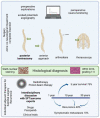Spinal Solitary Fibrous Tumors: An Original Multicenter Series and Systematic Review of Presentation, Management, and Prognosis
- PMID: 35740510
- PMCID: PMC9221085
- DOI: 10.3390/cancers14122839
Spinal Solitary Fibrous Tumors: An Original Multicenter Series and Systematic Review of Presentation, Management, and Prognosis
Abstract
All solitary fibrous tumors (SFT), now histologically diagnosed by a positive nuclear STAT6 immunostaining, represent less than 2% of soft tissue sarcomas, with spinal SFT constituting a maximum of 2% of them, making these tumors extremely rare. We provide an up-to-date overview of their diagnosis, treatment, and prognosis. We included 10 primary STAT6-positive SFT from our retrospective cohort and 31 from a systematic review. Spinal pain was the most common symptom, in 69% of patients, and the only one in 34%, followed by spinal cord compression in 41%, radicular compression, including pain or deficit, in 36%, and urinary dysfunction specifically in 18%. Preoperative diagnosis was never obtained. Gross total resection was achieved in 71%, in the absence of spinal cord invasion or excessive bleeding. Histologically, they were 35% grade I, 25% grade II, and 40% grade III. Recurrence was observed in 43% after a mean 5.8 years (1 to 25). No significant risk factor was identified, but adjuvant radiotherapy improved the recurrence-free survival after subtotal resection. In conclusion, spinal SFT must be treated by neurosurgeons as part of a multidisciplinary team. Owing to their close relationship with the spinal cord, radiotherapy should be considered when gross total resection cannot be achieved, to lower the risk of recurrence.
Keywords: STAT6; hemangiopericytoma; intramedullary; medulla; neurosurgery; solitary fibrous tumor; spine.
Conflict of interest statement
The authors declare no conflict of interest.
Figures



References
-
- Louis D.N., Perry A., Wesseling P., Brat D.J., Cree I.A., Figarella-Branger D., Hawkins C., Ng H.K., Pfister S.M., Reifenberger G., et al. The 2021 WHO Classification of Tumors of the Central Nervous System: A Summary. Neuro Oncol. 2021;23:1231–1251. doi: 10.1093/neuonc/noab106. - DOI - PMC - PubMed
-
- Robinson D.R., Wu Y.-M., Kalyana-Sundaram S., Cao X., Lonigro R.J., Sung Y.-S., Chen C.-L., Zhang L., Wang R., Su F., et al. Identification of Recurrent NAB2-STAT6 Gene Fusions in Solitary Fibrous Tumor by Integrative Sequencing. Nat. Genet. 2013;45:180–185. doi: 10.1038/ng.2509. - DOI - PMC - PubMed
-
- Ando M., Kobayashi H., Shinozaki-Ushiku A., Chikuda H., Matsubayashi Y., Yoshida M., Saito Y., Kohsaka S., Oda K., Miyagawa K., et al. Spinal Solitary Fibrous Tumor of the Neck: Next-Generation Sequencing-Based Analysis of Genomic Aberrations. Auris Nasus Larynx. 2020;47:1058–1063. doi: 10.1016/j.anl.2019.12.001. - DOI - PubMed
Publication types
LinkOut - more resources
Full Text Sources
Research Materials
Miscellaneous

